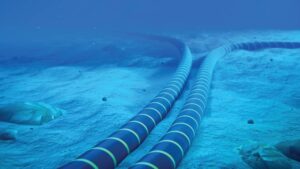GS III-Science and Technology

Context:
Airtel’s 2Africa Pearls subsea cable recently made landfall in India, significantly expanding internet capacity by 100 Tbps. This development underscores the urgent need for a strong undersea cable framework.
What Are Undersea Cables?
Definition:
Submarine or underwater cables are fibre-optic lines laid along the seabed, facilitating high-speed internet and telecommunication links across continents.
Global Reach:
By early 2025, over 600 active and planned submarine cables span around 1.48 million kilometers worldwide.
How Do They Function?
- Fiber-Optic Transmission:
These cables carry digital data using laser-generated light pulses transmitted through ultra-thin glass fibres. - Decoding Mechanism:
At the receiving end, the light signals are converted back into digital information for internet use. - Cable Placement:
Near shores, they are buried to avoid damage; in deep sea, they rest directly on the ocean bed. - Routing Considerations:
Engineers design routes to bypass high-risk zones like fault lines, anchoring areas, and busy fishing zones. - Data Capacity:
Capable of transmitting hundreds of terabits per second, these cables ensure seamless global digital communication.
Characteristics of Submarine Cables
- Structure:
Despite their massive capacity, they are similar in thickness to a garden hose, with fibre cores as thin as a human hair. - Layered Protection:
Enclosed in layers of plastic, steel, and insulation. Near the coast, additional armouring provides extra durability. - Notable Examples:
- Shortest: CeltixConnect (131 km, linking Ireland and the UK)
- Longest: Asia-America Gateway (approx. 20,000 km)
- Landing Infrastructure:
These cables connect to land-based stations that distribute internet through local networks. - Global Reach:
Most coastal nations are linked, with multiple cables providing redundancy to prevent complete outages.
Why Are Underwater Cables Important?
- Digital Backbone:
They power everything from emails and streaming to financial transactions and cloud computing. - Economic Importance:
Facilitate over $10 trillion in financial exchanges and enable 80% of global trade via digital infrastructure. - Data Sovereignty:
Enhances independence by reducing dependence on satellites or external internet routes. - Security Element:
Vital for secure and encrypted communication—especially in defense and diplomacy. - Tech Growth Catalyst:
Supports innovation, digital services, and platforms like OTT, fintech, and remote work ecosystems.
Challenges for India’s Subsea Cable Ecosystem
- Disruption Risk:
Damage to cables—such as those in the Red Sea in 2023—disrupted 25% of India’s internet connectivity. - High Centralisation:
Around 95% of cables land in a narrow 6 km stretch in Mumbai, forming a critical bottleneck. - Bureaucratic Hurdles:
More than 50 approvals are needed for cable deployment, leading to delays. - Repair Deficiencies:
India depends on foreign ships for repairs, which are slowed by clearance processes and lack of local repair vessels. - Human-Driven Damages:
Activities like fishing and dredging often harm cables—e.g., damage near Mumbai’s Versova coast.
The Way Forward
- Regulatory Simplification:
Introduce single-window clearance systems to streamline permissions. - Location Diversification:
Establish alternative landing points in places like Kochi and Vishakhapatnam to reduce reliance on Mumbai. - Strengthen Domestic Repair:
Invest in India-based cable maintenance ships and regional repair hubs to enable swift action. - Collaborative Infrastructure:
Promote partnerships between government and private entities to share investments and expand capacity. - Strategic Integration:
Align undersea cable projects with India’s broader Digital Public Infrastructure strategy to build resilience.
Submarine cables form the invisible backbone of India’s digital journey. However, the current system’s centralised layout and regulatory complexity make it vulnerable. Enhancing regulatory efficiency, expanding landing zones, and building indigenous repair capacity are essential to ensure robust digital connectivity. A future-ready undersea cable network will play a crucial role in achieving the vision of Digital Bharat.




